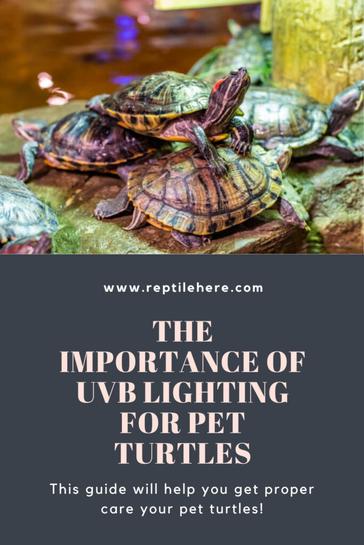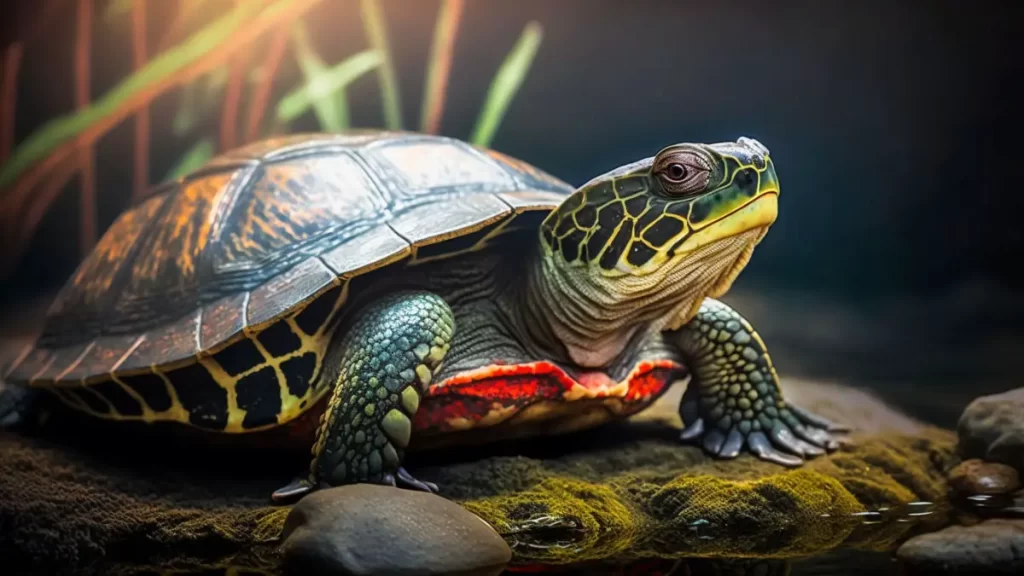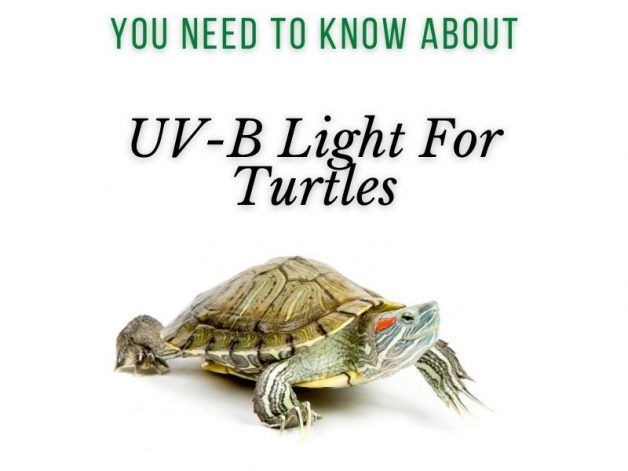Want to ensure that your turtle stays healthy and happy? One crucial factor to consider is UVB lighting. Providing your turtle with the right amount of UVB exposure is essential for its overall well-being. In this article, we will explore the importance of UVB lighting for your turtle’s health and discuss how it can affect everything from shell development to vitamin synthesis. So, whether you’re a new turtle owner or looking to enhance your pet’s care, read on to discover the vital role UVB lighting plays in maintaining your turtle’s health.

Why UVB Lighting Is Essential for Turtles
The Physiology of Turtles and UVB Light
Turtles are unique reptiles that require UVB lighting for their overall health and well-being. UVB light is a specific wavelength of ultraviolet light that helps turtles metabolize calcium, maintain healthy shell growth, and support their immune system. Without adequate UVB exposure, turtles may suffer from various health issues, including shell deformities, weakened immune systems, and metabolic bone disease.
The Role of UVB Light in Calcium Metabolism
Calcium is a vital nutrient for turtles, especially for the development and maintenance of their shells and bones. Turtles need UVB light to synthesize vitamin D3 in their skin, which enables the absorption of calcium from their diet. Without sufficient UVB exposure, turtles’ calcium metabolism becomes disrupted, leading to a deficiency that can cause skeletal abnormalities, such as soft shells, limb deformities, and even organ failure.
The Impact of UVB Light on Shell Health
Turtles’ shells are their protective armor, and UVB light plays a significant role in maintaining the health of their shells. UVB exposure stimulates shell growth and development, ensuring that the shell remains strong and sturdy. Insufficient exposure to UVB light can result in shell deformities, such as pyramiding, where the shell develops pyramid-like bumps instead of growing evenly. Additionally, a lack of UVB light can lead to a weakened shell structure, making turtles more susceptible to injuries and infections.
The Dangers of Inadequate UVB Lighting
UVB Deficiency Symptoms
Recognizing the signs of UVB deficiency in turtles is crucial to prevent serious health complications. One of the most evident symptoms is a lack of appetite and sluggishness. Turtles with a UVB deficiency may also exhibit reduced activity levels, weight loss, and abnormal behaviors, such as hiding excessively. Skin and shell problems, such as discoloration, flaking, or softening, can also indicate a lack of UVB exposure.
Shell Deformities and Softening
Inadequate UVB exposure can lead to severe shell deformities and softening in turtles. Soft shells occur when the shell lacks proper mineralization, making it pliable and vulnerable to damage. This condition not only affects the turtle’s physical appearance but also increases the risk of injuries and infections. Shell deformities, such as pyramiding, are also common in turtles deprived of sufficient UVB light. These abnormalities not only affect their appearance but can also impact their mobility and overall well-being.
Weakened Immune System
UVB light is integral to a turtle’s immune system. Adequate exposure to UVB helps turtles produce antimicrobial peptides, which are essential for fighting off infections and diseases. Without enough UVB light, the immune system becomes compromised, leaving turtles more susceptible to pathogens and making it harder for them to recover from illnesses. A weakened immune system also puts turtles at a higher risk of developing respiratory infections and other health complications.
Choosing the Right UVB Lighting for Your Turtle
Understanding UVB Wavelengths
When selecting UVB lighting for your turtle, it’s important to understand the different wavelengths available. UVB light is measured in nanometers (nm), with a range between 290nm and 320nm being optimal for turtle health. Turtles require UVB wavelengths specifically designed for reptiles, as regular fluorescent or incandescent bulbs do not emit sufficient UVB light. It’s essential to choose bulbs that provide enough UVB output to effectively meet your turtle’s needs.
Types of UVB Lights
There are several types of UVB lights available on the market, including fluorescent tubes and compact bulbs. Fluorescent tubes are commonly used in larger enclosures as they offer a wider area of light coverage. Compact bulbs, on the other hand, are suitable for smaller enclosures and provide a concentrated beam of UVB. Some UVB lights also come with a combination of UVA and UVB wavelengths, which can provide additional benefits to your turtle’s overall well-being.
Factors to Consider When Selecting UVB Lights
When selecting UVB lights for your turtle, it’s crucial to consider factors such as the size of your turtle’s enclosure, the distance between the light and the basking area, and the intensity of the UVB output. The size and type of your turtle species also play a role in determining the appropriate UVB lighting requirements. It’s advisable to consult a herpetologist or reptile specialist to ensure you choose the right UVB lights that meet your turtle’s specific needs.
Setting Up a Proper UVB Lighting System
Proper Placement of UVB Lights
To maximize UVB exposure for your turtle, it’s important to place the UVB lights in the correct position within the enclosure. The lights should be positioned above the basking area where your turtle spends most of its time. The distance between the light and the basking spot is crucial, as too far or too close can result in inadequate or excessive UVB exposure. It’s recommended to follow the manufacturer’s instructions or seek advice from a reptile expert for proper placement.
Creating a Light Cycle for Your Turtle
Turtles require a consistent light cycle to mimic their natural environment. UVB lights should be turned on for 10-12 hours a day to provide sufficient exposure. It’s important to establish a regular light cycle, ideally matching the natural daylight cycle, to ensure your turtle gets the appropriate amount of UVB light. Using a timer can help automate the light cycle and provide a consistent routine for your turtle.
Tips for Adjusting Light Intensity
The intensity of UVB light should be monitored to ensure it meets your turtle’s needs. If the UVB light is too weak, the turtle may not receive enough UVB exposure for proper calcium metabolism. If the light is too strong, it can potentially cause eye damage or stress to the turtle. Be cautious when adjusting the light intensity and observe your turtle’s behavior and health to determine the optimal level.

Providing Accessible Basking Spots for UVB Exposure
Creating a Basking Area in the Enclosure
Turtles need a basking area where they can expose their bodies to both UVB light and heat. The basking area should provide a flat, dry surface for the turtle to comfortably rest and bask. Rocks or logs can be placed in the enclosure to create an elevated platform where the turtle can climb and bask. Ensure that the basking area is easily accessible, especially for young or small turtles, to promote regular UVB exposure.
Choosing the Right Basking Spot Temperature
In addition to UVB light, turtles require a suitable basking spot temperature to regulate their body temperature and aid in digestion. The basking spot should have a temperature range between 85°F and 95°F (29°C and 35°C) for most turtles. Installing a thermometer in the basking area will help monitor and maintain the correct temperature. A warm and comfortable basking spot encourages turtles to spend more time under the UVB light, ensuring they receive adequate exposure.
Monitoring Basking Behavior
Observing your turtle’s basking behavior is essential to ensure it’s receiving enough UVB exposure. Turtles typically bask more frequently when they require UVB light. If your turtle spends minimal time basking or avoids the basking area altogether, it may indicate an issue with the UVB lighting setup or a potential health concern. Regularly monitor your turtle’s basking behavior to ensure it’s receiving the correct amount of UVB exposure.
UVB Lighting Maintenance and Replacement
Regularly Checking UVB Lights
UVB lights degrade over time, even though they may still emit visible light. It’s crucial to regularly check the UVB light intensity to ensure it’s still providing adequate output. UVB meters are available for measuring the UVB output, or you can consult a reptile specialist for assistance. Regular checks will help identify when it’s time to replace the UVB bulb, ensuring your turtle consistently receives the necessary UVB exposure for its health.
Replacing UVB Lights
UVB bulbs should be replaced regularly, even if they appear to be working. The general recommendation is to replace UVB bulbs every 6 to 12 months, as their UVB output diminishes over time. It’s essential to follow the manufacturer’s guidelines for replacement intervals specific to the brand and type of UVB light you’re using. Regularly replacing UVB bulbs guarantees that your turtle continues to receive optimal UVB exposure for its well-being.
Importance of Regular Cleaning
Maintaining a clean environment for your turtle’s UVB lighting system is crucial. Dust, debris, and calcium deposits can accumulate on the UVB bulbs and fixtures, reducing their efficiency and blocking UVB light. Regularly clean the UVB bulbs and fixtures according to the manufacturer’s instructions to ensure they are functioning at their best. A clean UVB lighting system ensures that your turtle receives the maximum benefits of UVB exposure.

Understanding the Importance of Vitamin D3 Supplements
The Role of Vitamin D3 in Turtle Health
Vitamin D3 is essential for turtles as it helps regulate calcium metabolism and ensures proper bone and shell health. Turtles receive their vitamin D3 through UVB light exposure, which triggers its synthesis in the skin. However, in certain situations where UVB exposure may be limited or inadequate, providing vitamin D3 supplements becomes necessary to prevent vitamin D3 deficiency and related health issues.
Supplementing UVB Lighting with Vitamin D3
In cases where turtles may not receive sufficient UVB exposure, additional vitamin D3 supplementation can help maintain their health. However, it’s crucial to consult with a reptile veterinarian or herpetologist for proper dosage and administration. Excessive vitamin D3 supplementation can lead to overdose, causing toxicity and potentially fatal health complications. Vitamin D3 supplements should be used with caution and under professional guidance.
The Risks of Vitamin D3 Overdose
Vitamin D3 overdose can have severe consequences for turtles. Excessive vitamin D3 levels can lead to hypercalcemia, where there is an excessive buildup of calcium in the blood. This condition can cause kidney damage, digestive issues, and even heart problems. It’s crucial to follow expert advice and not rely solely on vitamin D3 supplements without ensuring adequate UVB exposure.
Common Myths and Misconceptions about UVB Lighting
UVB Light Penetrating Glass or Mesh
One common misconception is that UVB light can penetrate glass or mesh, effectively providing adequate exposure. In reality, most regular glass filters out the majority of UVB wavelengths, significantly reducing their ability to reach the turtles. Mesh or screens also block a significant amount of UVB light, further diminishing its effectiveness. To ensure proper UVB exposure, it’s important to provide unobstructed access to UVB rays by using appropriate lighting setups.
Alternatives to UVB Lighting
Some turtle owners may consider alternatives to UVB lighting, such as vitamin D3 supplements or relying solely on natural sunlight. While vitamin D3 supplements can be a temporary solution, they cannot fully replace the benefits of UVB light. Natural sunlight can provide UVB exposure, but it’s challenging to control and maintain consistent levels, and exposure to outdoor elements also carries risks. Artificial UVB lighting should be the primary source of UVB for turtles, supplemented with natural sunlight whenever possible.
The Need for UVB Lighting in Different Turtle Species
All turtle species, regardless of their natural habitat or lifestyle, require UVB lighting for their health. While the specific UVB intensity and exposure duration may vary depending on the species, no turtle can thrive without adequate UVB light. It’s important to research and understand the specific UVB lighting requirements of your turtle species to provide the optimal lighting setup and ensure their overall well-being.

The Effects of Natural Sunlight on Turtles
Benefits of Outdoor Sun Exposure
Outdoor sunlight can provide turtles with additional benefits beyond UVB exposure. It allows them to experience natural temperature fluctuations and vitamin-rich natural surroundings. Natural sunlight also promotes exercise and stimulates their natural behaviors, enhancing their overall quality of life. When weather conditions permit, allowing turtles supervised outdoor time can be beneficial to their physical and mental well-being.
Potential Risks of Outdoor UVB Exposure
While outdoor sunlight can be advantageous, it also carries risks for turtles. Exposure to extreme temperatures, predators, and potential escapes are concerns when allowing turtles outside. Additionally, it’s challenging to control and maintain consistent UVB exposure levels from natural sunlight alone. It’s crucial to ensure the turtle’s safety and monitor the exposure duration and intensity to avoid any adverse effects on their health.
Supplementing with Artificial UVB Lighting
Supplementing natural sunlight with artificial UVB lighting is essential to ensure turtles receive a consistent and controlled UVB exposure. While outdoor sunlight can provide occasional enrichment, it should not be the sole source of UVB for turtles. Artificial UVB lighting allows for precise control of UVB wavelengths, intensity, and duration, ensuring turtles receive optimal exposure regardless of weather conditions or seasonal changes.
Consulting a Herpetologist for Expert Advice
The Importance of Professional Guidance
For proper UVB lighting setup and to address any concerns about turtle health, consulting a herpetologist or reptile specialist is highly recommended. These professionals have in-depth knowledge and can provide expert guidance on UVB lighting requirements, proper care, and identifying and addressing any health issues. Seeking professional advice ensures that your turtle receives the best possible care and support for their overall well-being.
Seeking a Herpetologist’s Opinion
If you have any doubts or questions about UVB lighting or your turtle’s health, don’t hesitate to consult a herpetologist or reptile veterinarian. They can evaluate your turtle’s current living conditions, provide specific advice based on your turtle species, and address any concerns or issues you may have. A herpetologist’s opinion and expertise can provide peace of mind and help you make informed decisions regarding your turtle’s care.
Specific Care Recommendations for Your Turtle
Every turtle is unique, and their care requirements may vary based on factors such as species, age, size, and overall health. Consulting a herpetologist or reptile specialist allows you to receive personalized care recommendations tailored to your specific turtle’s needs. They can provide guidance on UVB lighting setup, diet, enclosure conditions, and any necessary adjustments to ensure your turtle’s health and happiness.
In conclusion, UVB lighting is essential for turtles’ overall health and well-being. Adequate exposure to UVB light enables proper calcium metabolism, supports shell health, and strengthens the immune system. Understanding the physiology of turtles and their UVB lighting requirements is crucial for providing optimal care. Choosing the right UVB lighting, setting up a proper lighting system, and creating accessible basking spots are key factors in maintaining a healthy UVB environment for your turtle. Regular maintenance, supplementation with vitamin D3, and debunking common myths about UVB lighting further contribute to your turtle’s health. Lastly, consulting a herpetologist ensures expert advice and specific care recommendations tailored to your turtle’s needs, ensuring a happy and thriving companion for years to come.

